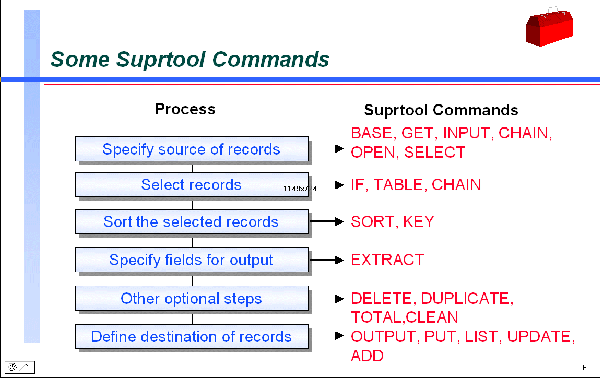
Suprtool Coding Tips
Neil ArmstrongSuprtool is not only a database tool, but is also a language. Like any "programming" language there are things you can do to improve the readability of the scripts you are writing.
Suprtool does very little work when accepting commands. It does syntactic checking and some semantic checking of the commands, but Suprtool does very little work until you "xeq" the task or exit. (The Table command is the exception to this rule as it may have to read and sort a file to fill the table!)
Here is some sample bad code (although it is syntactically correct, the ordering of the commands does not make the logic clear):
base mytest,5 table mytable,order-number,file,myords get mydataset item order-date,date,ccyymmdd output myfile,link sort order-number ext order-number if order-date=$today(-1) and $lookup(mytable,order-number) sort order-date ext order-quantity,order-ctgy ext order-description ext order-dollars ext order-tax xeq exit
Writing good Suprtool code can be achieved by simply dividing up commands into some simple categories.
These categories are:
- Source of Records
- Selection of records
- Order of records
- Fields for output
- Optional Steps
- Destination of records

So applying this slide to the previous code we would get the following:
base mytest,5 get mydataset table mytable,order-number,file,myords item order-date,date,ccyymmdd if order-date=$today(-1) and $lookup(mytable,order-number) sort order-number sort order-date ext order-number ext order-quantity ext order-ctgy ext order-description ext order-dollars ext order-tax output myfile,link exit
We moved the code around to be separated into logical groupings, making the code a lot easier to read and maintain. The Table command is near the If command for easy reference. The Item command is before the If command and is necessary to tell the If command the date type that the order-date is, so I keep it near the If command. We have a clear definition of the input source.
The two sort keys are clearly defined as well as each field.
If you needed to define a field to rename a field being extracted, say order-dollars to be order-total, I would change the script as follows:
base mytest,5 get mydataset def order-total,1,4,double table mytable,order-number,file,myords item order-date,date,ccyymmdd if order-date=$today(-1) and $lookup(mytable,order-number) sort order-number sort order-date ext order-number ext order-quantity ext order-ctgy ext order-description ext order-total=order-dollars ext order-tax output myfile,link exit
The Define commands can be grouped where you specify the input source, or even as I have them, as their own separate section. Next time you are developing some Suprtool scripts, why not give this guideline a try. We trust you will find your code much more readable.